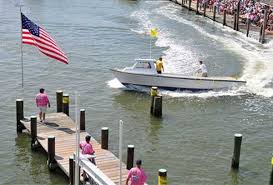DOCKING YOUR BOAT
The best way to get good at docking is practice, practice, practice. With repetition, you start to get a feel for wind and current. Try to get someone with experience to teach you (on your boat, if possible). (And, by the way, I don’t recommend that person to be a spouse. You need a professional marineeducator or experienced boater.)

Here’s some useful tips.
Patience !! You were not born knowing how to drive a boat just as you were not born knowing how to drive a car. You had to learn. A boat steers from the stern and pivots on its axis. So, when you steer to the right, for example, the stern of your boat moves to the left (which may explain why you are bumping into the slips on the next dock over).
I also like to use visualization. As you are approaching your slip, make an imaginary line from the center of the bow of your boat, on a slow arcing curve into the middle of the slip. Practice keeping your boat on this imaginary line. If your boat is drifting to the left of the line you need to steer more right. If it is drifting to the right of the line you need to steer more left.
When approaching your slip you need to have some momentum to overcome any wind or current. However, momentum does not equal speed. You want just enough to get into the slip and be able to shift smoothly into reverse to stop the boat. You should also be aware that when you shift to reverse, even with the wheel centered, your stern will tend to "walk" to port because of the counter clockwise rotation of the prop.
If there is not enough room between rows of slips to do this in one continuos arc, you'll need to use reverse and make a few "course adjustments." Remember when you do this that, as you stop the momentum of the boat, the boat is more susceptible to wind and current. You need to anticipate the effects of both so that you end up where you want to be.
Wind and current will determine where you should actually begin your maneuvers in relation to your slip.
If at all possible, you want to dock into wind or current. Even if it means going past your slip and turning around and approaching from the opposite direction. It is easier to handle a boat into wind and current and it also helps slow you down as you enter your slip.